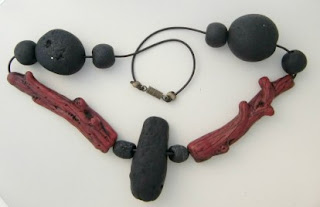One of the fabulous things about polymer clay (and the internet) if that the material is flexible enough to allow for a range of experimentation; people are constantly taking a technique which they have learned, and adding to it--sort of like that old game of 'telephone', where a word or phrase passes from person to person, until it comes full circle in a nearly unrecognizable form.
Last year I published a tutorial on making faux twigs, after much experimentation
 on my own; I, of course, was influenced by looking at other artists--Kim Cavender, especially.
on my own; I, of course, was influenced by looking at other artists--Kim Cavender, especially.My take on the faux twigs was in pursuit of realistic looking lightweight polymer pieces that could be included in jewelry--and one of the weaknesses of the tutorial was that it required the artist to drill after curing--something that many people are neither set up for, nor comfortable with.
Of course I included sugggestions such as wirewrapping to add the elements, but still....
So I was completely delighted the other day to get a lovely email from an artist in Italy, who had come up with a brilliant and beautful way to overcome the drilling problem:

 Her screen name is Primatoide Futile, and her work is notable for the sophistication that she achieves with simple palletes and shapes--but what knocked me out was her elegant solution for the non-drillers among us--she simply combined two techniques--creating hollow tubes in polymer, then creating the twig around it;
Her screen name is Primatoide Futile, and her work is notable for the sophistication that she achieves with simple palletes and shapes--but what knocked me out was her elegant solution for the non-drillers among us--she simply combined two techniques--creating hollow tubes in polymer, then creating the twig around it;
Voila!! A twig that can be strung lengthwise, easy-peazy.
Prima didn't say, but I suspect that she cures her hollow tubes after creating them on a knitting needle or other armature, then adds the raw clay to the surface, and molds and textures it
as instructed in the tutorial; the look is smashing.
As always, I learn as much or more from my students than they do from me....
Namaste,
Randee
No comments:
Post a Comment